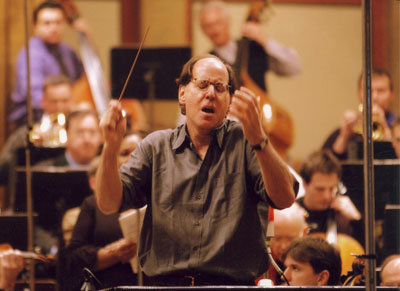Views: 179

最新一期《經濟學人》The Economist有一篇關於美國音樂奇才Gilbert Kaplan的傳奇故事。(原文轉載于後)
文章的副題寫道﹕
他只指揮一首交響曲﹕馬勒第二。但開普蘭Gilbert Kaplan卻令聽眾與音樂家從根本改變了對馬勒的看法。
馬勒也是令我瘋狂的音樂家,但開普蘭令我最感興趣的是音樂以外的啟示。
有趣的是,開普蘭出身自華爾街的大後方。1965那年他才24歲,靠借回來的十萬美元創辦了Institutional Investor《機構投資者》雜誌。這份雜誌後來成為全世界金融界人手一份的刊物,他差不多二十年後才以七千多萬美元把雜誌賣掉。
但令他最有名的馬勒第二卻來得有點偶然。就在他創辦《機構投資者》的同一年,一個下午一位朋友帶他去紐約肯內基音樂廳觀看指揮家Leopold Stokowski排演馬勒第二交響曲。
那天晚上,開普蘭在床上輾轉反側老是想著馬二,一直沒法入睡。
第二天,他索性買票進場聽正式的演出,在整個演奏當中,他竟然不停揭斯底里地飲泣。
之後,他完全迷上了馬二。所有馬二的演奏他都不肯放過,連他的太太也是在一場倫敦的音樂會因為坐在他身旁而結識的。
終于他成為這首交響樂的首屈一指大權威,連正規的音樂家也要向這位業餘「發燒友」請教。

美國常會產生這樣一種平常人眼中的「瘋子」。
這令我想起前一陣子聽一個投資講座,講者認為美國的金融風暴會比日本八、九十年代那場結束得快。他的理由是美國人性子急,不會像日本人那樣拖泥帶水。我很佩服那位講者,我覺得這觀察勝過一百張圖表。
開普蘭不正是這種典型的美國人嗎?
開普蘭在擔任第一場馬二指揮的演出後這樣說﹕“我感覺我的聽眾在鼓勵我去圓夢。他們那天晚上就像與我同台演出、與洋基幫球隊一起打球、寫他們從沒寫出來的書,又把他們從沒追到的女孩子追到手”。
開普蘭是否在對我們說﹕他與其他紐約人、美國人無異,他不過是把他們想做但沒膽量做的事做出來罷了?
我的想像走得更遠。
開普蘭的天才,與這次炮制次貸金融海嘯的華爾街銀行家的才華,在本質上是一樣的嗎?
開普蘭是個猶太人名字,是否他的猶太人宗教情懷令他對他的族人馬勒特別有認同感?猶太人認為他們是上帝選定的子民。美國人呢?
美國人把西方人的「理性瘋狂」表現得最淋灕盡致,所以開普蘭與他的銀行家讀者對我還有另外一重啟示。
我常常在猜想﹕西方自啟蒙時代把科學搬上神台以後,在日常生活裏他們尊奉理性主義,而宗教則躲在廟堂裏。這是種二元分裂,是不穩定的平衡狀態。
有些人像開普蘭可以從音樂、宗教找到安身立命之所,但他在華爾街的一些朋友卻把理性主義——對市場的崇拜,變成新的宗教,這種原教主義引發的災難與911相比,孰輕孰重,又有誰可以說得清?
The Economist原文
Desperately seeking Mahler
From The Economist print edition
He conducts just one symphony, Mahler’s second. But Gilbert Kaplan has radically changed the way Mahler is perceived, both by audiences and other musicians
ONE April Saturday in 1965, an economist at the American Stock Exchange was taken by a friend to an orchestral rehearsal at Carnegie Hall. He watched impassively as Leopold Stokowski, the aged Hollywood maestro who conducted “Fantasia”, stop-started Gustav Mahler’s Symphony No.2 in C minor all afternoon. The economist thought little of it until later that night, when, sleeplessly, he tossed and turned, haunted by the music he had heard. Next morning he bought a ticket and at the concert “just found myself sobbing, absolutely hysterical”.
The young man was about to launch a publishing business and, with it, to define an occupation. With $100,000 borrowed from Gerald Bronfman, a whisky magnate, and $50,000 from banks, friends and his own savings, Gilbert Kaplan, 24 years old, founded Institutional Investor, a monthly magazine that brought together bankers, analysts and money managers. It quickly became an essential means of communication for financiers, attracting 150,000 subscribers in 140 countries. Before the 1960s were over Mr Kaplan was a millionaire and on first-name terms with finance ministers and international bankers.
But Mahler’s symphony would not let him rest. Over the next few years he attended every performance within reach, met his future wife in the adjacent seat at London’s Royal Festival Hall and, as the obsession intensified, took 18 months off work to study the score and discuss it with such leading interpreters as Leonard Bernstein, Sir Georg Solti and Leonard Slatkin. In September 1982, after an International Monetary Fund summit, he put his reputation on the line by conducting the American Symphony Orchestra in a private performance for financiers and politicians at the Lincoln Centre. A former British prime minister, Sir Edward Heath, himself a spare-time conductor, called it “a very remarkable feat”, but that was, if anything, an understatement.
Mahler’s second symphony, known as the “Resurrection” for its rousing choral climax and theological theme, is one of the trickiest works in the repertory, a 90- minute epic involving a huge orchestra, chorus, two vocal soloists and an invisible offstage group of brass and percussion that seldom come in on cue. Discussing the purpose of life on earth, its unwieldiness regularly defeats the best efforts of famous maestros. For a rank amateur to accomplish a performance without breaking down in the vast finale was tantamount to a musical revolution. Privately Mr Kaplan now admits that if the musicians had failed to respond to his beat or the music fell apart (as it sometimes does in the best of hands), his fallback plan was to turn around to the audience and announce: “Ladies and gentlemen, dinner is served.”
His feat, discreet though it was, reverberated throughout the music world. Over the following years Mr Kaplan was invited to conduct flagship ensembles at La Scala in Milan, in Munich and Vienna, to open the prestigious Salzburg festival and to give the work its Chinese premiere in Beijing. His recording, made in Cardiff in 1985, has outsold Bernstein, Pierre Boulez, Claudio Abbado and all other contenders. On December 8th his odyssey reaches an emotional apotheosis when he conducts the work with the New York Philharmonic at the Lincoln Centre’s Avery Fisher Hall 100 years to the night after the composer, with the same orchestra, gave the piece its American premiere.
Pleasing as this symmetry will be to the now-retired publisher, the results of his presumption are far-reaching. Mr Kaplan is acknowledged as the leading technical authority on Mahler’s second symphony, consulted by many professional maestros on matters of detail. He was the first to import television screens and cameras to communicate with the offstage band, a device now in common use.
He owns the composer’s manuscript, acquiring it in 1984 from a Dutch foundation, publishing it in facsimile and obliging Vienna’s Universal Edition to print a corrected new score which is faithful to Mahler’s final amendments. The Vienna Philharmonic gave its first note-perfect performance under Mr Kaplan’s baton and he experienced his deepest satisfaction when the horn section, struggling in a recording session to accommodate the changes, played one passage 11 times in their earnestness to get it right.
Mr Kaplan’s involvement with the second symphony has made it probably the most talked-about of Mahler’s works, diverting public attention away from the morbidity of his last great pieces. The long-standing image of Mahler as a composer of doom has been set aside, in part through Mr Kaplan’s advocacy.
That an unskilled dreamer could teach professionals how to bring off a masterpiece is a fantasy that many share but few presume to achieve. Mr Kaplan, after his first performance, said: “I had a feeling that people in the audience were urging me to fulfil my dream. They were up with me on the podium that night, playing baseball for the Yankees, writing the book they never wrote or getting the girl they never got.”
His has been a triumph of ambition over intractable matter, a fulfilment of Mahler’s faith in Arthur Schopenhauer’s idea that the human will can overcome any force on earth. Or, in more contemporary Obamist rhetoric, Yes We Can.